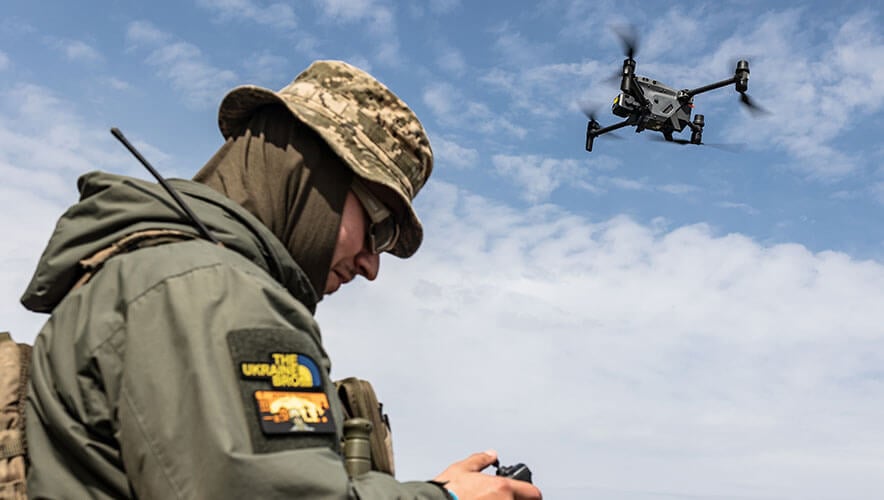Ukraine Launches Tech Cluster to Boost Drone Innovation on Front Lines
The war in Ukraine continues to be waged on the front lines, in cyberspace, and in the skies. Ukraine is rapidly increasing its production of drones—relaxing import laws and scrapping taxes for drone parts and equipment—as demand for the devices grows on the front line, the BBC reported.
The expansion of the drone combat program is being funded by the Army of Drones fundraising campaign, which has raised more than $108 million so far to purchase or build drones and train new pilots.
The drones—mostly small hobby drones that are cheap (less than $2,000 for the most common drone) and commercially available—are being used to search for enemy forces and infrastructure to dramatically improve Ukrainian forces’ aim when firing artillery. Some Ukrainian-built drones are designed to be crashed into enemy targets. Meanwhile, Russia has deployed Iranian-built Shahed-136 exploding drones to damage Ukrainian power plants. Russia has also accused Ukraine of launching kamikaze drone attacks inside Russian territory—an allegation Ukraine has never admitted to.
Ukraine announced in January that it was setting up drone assault companies within its armies. Ukraine’s defense minister told Reuters that he saw drones as the future of modern warfare.
This could have noteworthy implications for both military and private security situations, says Bill Edwards, CPP, PCI, PSP, president of Building Intelligence Inc. and a former U.S. Army colonel.
“Drones or the concept of drones is not new,” he says. “However, the evolution, maturity in capability, accessibility, and innovative use cases are constantly and most recently consistently changing especially in the Ukraine conflict. We’ve seen the conversion of recreational drones for use as surveillance platforms and now for weapons delivery. The advent of first-person view (FPV) in the tactical fight is a game-changer and possibly a revolution in military affairs as it pertains to a technological advancement.”
Edwards ranks drone use in the Ukraine war alongside previous military revolutions such as the introduction of the machine gun to World War I trench warfare and the use of social media during the Arab Spring and subsequent conflicts in Iraq and Syria.
“Security professionals need to address and add the ‘air domain’ to their security, safety, and emergency preparedness program,” he adds. “The evolution and maturity of commercial drone technology demand this attention. We can no longer afford not to.”
The Ukrainian government wants to bring public and private sector developers together into a military technology cluster, hoping new drones and other forms of electronic warfare would give Ukraine a battlefield advantage against Russia. https://t.co/ONgPK5JERs
— AP Europe (@AP_Europe) April 26, 2023
While some Chinese manufacturers banned exports of their hobby drones to Ukraine and Russia last year, Ukraine has still been able to obtain thousands of them. In addition, 400 people have sent their own hobby drones through the mail to Ukraine after the country appealed for “dronations.”
The small drones have been useful so far, but countermeasures have rapidly grown to meet the challenge. The devices are often shot down or jammed by electronic weapons, the BBC said.
Ukraine launched a new initiative today to streamline and promote drone and technology innovation, especially related to the war with Russia. The initiative, dubbed BRAVE1, will bring state, military, and private sector developers together in a tech cluster to work on defense issues. The government earmarked around $2.7 million to fund these projects, the Associated Press said.
Security Management is developing a package of articles specifically about drone use and counter-UAS procedures. The content will be released in May 2023. Previous coverage about drone risk management includes:
- Lessons from the War in Ukraine: Commercial Drones Used for Combat
- Better Drone Detection Needed for Threat Assessments
- The Critical Role of C-UAS in Perimeter Security Systems
- Dreaming of Gadgets and the Drone Revolution
- Developing Best Practices for Shooting Down Drones










